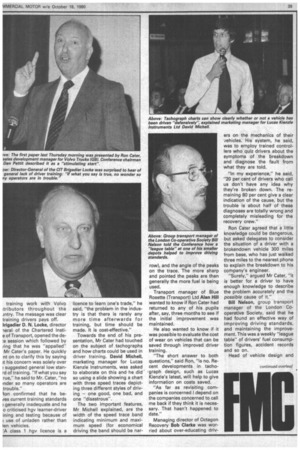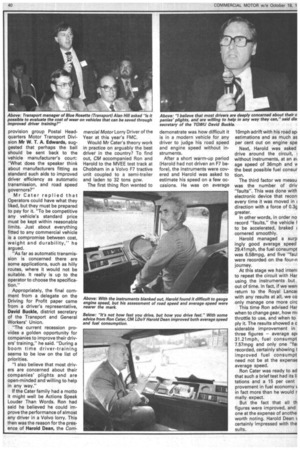Driving at economy
Page 40

Page 41

Page 42

If you've noticed an error in this article please click here to report it so we can fix it.
RON CATER is not a man to mince words. He says and writes exactly what he thinks and while his paper Driving for Profit on the face of it didn't seem contentious, his method of delivery stimulated the delegates into a lively debate.
Mr Cater stayed close to the Conference's general theme of profit throughout his presentation, emphasising that teaching people to drive is not his business, but teaching them to drive profitably is. That means reducing both fuel and maintenance costs.
There were nods of recognition from many delegates at Ron Cater's slides show ing various types of driver some clumsy, some carelE but most well-intentioned but informed.
"Would you allow a drivel drive off in your new Re Royce without at least explz ing to him how to operate automatic transmission and conditioning?" Ron asked.
He then went on to say thal too often drivers were sent in new commercial vehic costing as much as a Rolls, w out any training in the right v of driving it.
To show the kind of impro ments that could be achiel with even minimal training, Cater used the results of somi training work with Volvo tributors throughout the intry. The message was clear training drivers pays off.
Irigadier D. N. Locke, director leral of the Chartered Instie of Transport, opened the de;e session which followed by ring that he was "appalled" Mr Cater's paper. He quickly nt on to clarify this by saying it his concern was solely over suggested general low stanrd of training. "If what you say rue," he said to Mr. Cater, "no inder so many operators are trouble."
on confirmed that he bees current training standards generally inadequate and he o criticised hgv learner-driver ifling and testing because of use of unladen rather than len vehicles.
'A class 1 hgv licence is a licence to learn one's trade," he said, "the problem in the industry is that there is rarely any more time afterwards for training, but time should be made. It is cost-effective."
Towards the end of his presentation, Mr Cater had touched on the subject of tachographs and how charts could be used in driver training. David Michell, marketing manager for Lucas Kienzle Instruments, was asked to elaborate on this and he did so using a slide showing a chart with three speed traces depicting three different styles of driving one good, one bad, and one "disastrous".
The two important features, Mr Michell explained, are the width of the speed trace band indicating minimum and maximum speed (for economical driving the band should be nar row), and the angle of the peaks on the trace. The more sharp and pointed the peaks are then generally the more fuel is being used.
Transport manager of Blue Rosette (Transport) Ltd Alan Hill wanted to know if Ron Cater had returned to any of his pupils after, say, three months to see if the initial improvement was maintained.
He also wanted to know if it was possible to evaluate the cost of wear on vehicles that can be saved through improved driver training.
"The short answer to both questions," said Ron, "is no. Recent developments in tachograph design, such as Lucas Kienzle's latest, will help to give information on costs saved.
"As far as revisiting companies is concerned i depend on the companies concerned to call me back if they think it is necessary. That hasn't happened to date."
Managing director of Octagon Recovery Bob Clarke was worried about over-educating driv ers on the mechanics of their vehicles. His system, he said, was to employ trained controllers who quiz drivers about the symptoms of the breakdown and diagnose the fault from what they are told.
"In my experience," he said, -20 per cent of drivers who call us don't have any idea why they're broken down. The remaining 80 per cent give a clear indication of the cause, but the trouble is about half of these diagnoses are totally wrong and completely misleading for the recovery crew."
Ron Cater agreed that a little knowledge could be dangerous, but asked delegates to consider the situation of a driver with a brokendown vehicle 300 miles from base, who has just walked three miles to the nearest phone to explain the breakdown to his company's engineer.
"Surely," argued Mr Cater, "it is better for a driver to have enough knowledge to describe the problem accurately and the possible cause of it."
Bill Nelson, group transport manager of the London Cooperative Society, said that he had found an effective way of improving driving standards, and maintaining the improvement. This was a weekly "league table" of drivers' fuel consumption figures, accident records and so on.
Head of vehicle design and
provision group Postal Headquarters Motor Transport Division Mr W. T. A. Edwards, suggested that perhaps the ball should be sent back to the vehicle manufacturer's court: "What does the speaker think about manufacturers fitting as standard such aids to improved driver efficiency as automatic transmission, and road speed governors?"
Mr Cater replied that Operators could have what they liked, but they must be prepared to pay for it. "To be competitive any vehicle's standard price must be kept within reasonable limits. Just about everything fitted to any commercial vehicle is a compromise between cost, weight and durability," he argued.
"As far as automatic transmission is concerned there are some applications, such as hilly routes, where it would not be suitable. It really is up to the operator to choose the specification."
Appropriately, the final comment from a delegate on the Driving for Profit paper came from a driver's representative, David Buckle, district secretary of the Transport and General Workers' Union.
'The current recession provides a golden opportunity for companies to improve their drivers' training," he said. "During a boom time driver-training seems to be low on the list of priorities.
"I also believe that most drivers are concerned about their companies' plights and are open-minded and willing to help in any way."
If the Cater family had a motto it might well be Actions Speak Louder Than Words. Ron had said he believed he could improve the performance of almost any driver in a Volvo lorry. This then was the reason for the presence of Harold Dean, the Corn mercial Motor Lorry Driver of the Year at this year's FMC.
Would Mr Cater's theory work in practice on arguably the best driver in the country? To find out, CM accompanied Ron and Harold to the MVEE test track at Chobham in a Volvo F7 tractive unit coupled to a semi-trailer and laden to 32 tons gcw.
The first thing Ron wanted to demonstrate was how difficult it is in a modern vehicle for any driver to judge his road speed and engine speed without instruments.
After a short warm-up period {Harold had not driven an F7 before), the instruments were covered and Harold was asked to estimate his speed on a few occasions. He was on average
lOmph adrift with his road sp, estimations and as much as per cent out on engine spe
Next, Harold was asked drive around the circuit, without instruments, at an a\ age speed of 36mph and the best possible fuel consur tion.
The third factor we measu was the number of driv "faults". This was done with electronic device that recoil every time it was moved in z direction with a force of 0.3g greater.
In other words, in order no record "faults," the vehicle 1 to be accelerated, braked z cornered smoothly.
Harold managed a surp ingly good average speed 29.41mph, the fuel consumpt was 6,58mpg, and five "faul were recorded on the four-n journey.
At this stage we had intent to repeat the circuit with Har using the instruments but out of time. In fact, if we wen return to the Royal Lance: with any results at all, we co only manage one more circ This time Ron advised Har when to change gear, how mi throttle to use, and when to ply it. The results showed a c siderable improvement in three figures — average spi 31.21mph, fuel consumpt 7.57mpg and only one "faL recorded, certainly showing t improved fuel consumpt need not be at the expense average speed.
Ron Cater was ready to ad that such a brief test had its Ii tations and a 15 per cent provement in fuel economy in fact more than he would r mally expect.
But the fact that all th figures were improved, and one at the expense of anothei worth noting, Harold Dean 1, certainly Impressed with the suits.




























































































































































































































































































